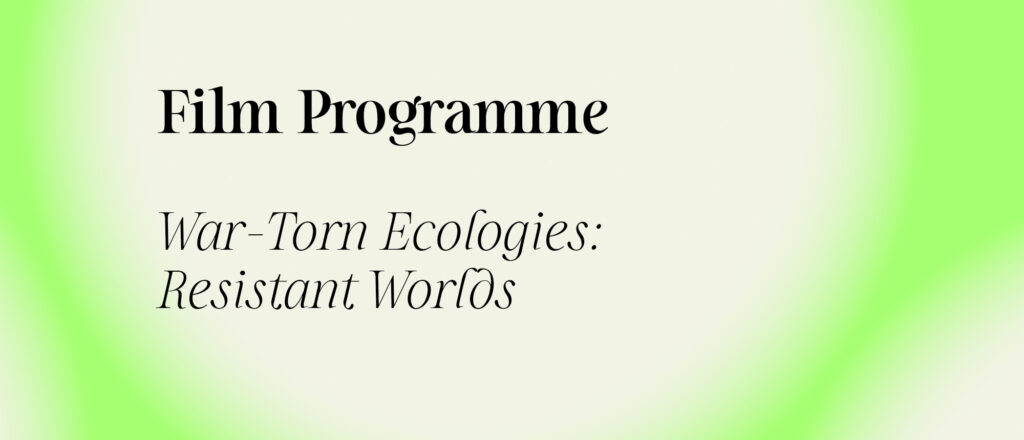
Share this:
War-Torn Ecologies: Resistant Worlds
Film Programme
27/06/24—29/06/24
Free – £5.00
Sign up for a reminder for this in person event. With a donation, you directly support our programme.
Enjoy this specially curated film programme as part of the project War-Torn Ecologies: Resistant Worlds.
Programme (152mins) on loop:
Suha Shoman | Bayyaritna (Orange Plantation) (2009, 8’9”)
Jumana Emil Abboud | Smuggling Lemons (2006, 20’18”)
Ruba Salameh | Yamm (Open Sea) (2016, 9’17”)
Inas Halabi | We Have Always Known the Wind’s Direction (2019, 11’57”)
Shada Safadi | Wind Farm (2023, 2’57”)
Kamal Aljafari | UNDR (2023, 14’44”)
Pejvak (Rouzbeh Akhbari & Felix Kalmenson) | Weak Enough to Hear: A Deluge in Six Acts (2019, 39′)
Sherko Abbas | Encounters on the Tigris (2023, 41’41”)
Manal Mahamid | From Akka to Gaza (2024, 4′)
About the films
Suha Shoman’s Bayyaritna (Orange Plantation) (2009, 8’9”) tells the history of an orange grove bought by Shoman’s grandfather in Gaza in 1929. The artwork is a sombre narration of the violent methodical destruction of the groves on her family’s land in Gaza by the Israeli occupation.
In Smuggling Lemons (2006, 20’18”), Jumana Emil Abboud repetitively records the social reality and exhausting procedure of crossing the checkpoints between Jerusalem and Ramallah. Making several journeys through the checkpoints, she smuggles the fruit of an entire lemon tree from its garden in Jerusalem. By presenting the landscape and the monotony of the journey, the video records the way that repression works, and the lemons that the artist carries in her arms and on her body take on different connotations.
Yamm (Open Sea) (2016, 9’17”) is a video work that captures Ruba Salameh’s persistent return to a bus stop in Salah Al-din Street in East Jerusalem – where a huge billboard of the sea of Gaza overlooks the awaiting passengers and passersby. The video captures the heart of everyday life in Jerusalem punctuated by the still Gazan sea, animated by film fragments from the beach at Tantoura, a Palestinian village demolished in 1948. Haunted by the notion of its very disappearance, the fading paper, its wear and tear, the marks of time and human intervention symbolically speak of erasure, separation, memory, impossibility and resistance.
We Have Always Known the Wind’s Direction (2019, 11’57”) by Inas Halabi explores the material effects of radiation (physically and metaphorically) and the possible burial of nuclear waste in the south of the West Bank. Radioactivity, invisible but deadly, is here a synecdoche for a more ungraspable invisibility—the systemic networks of power and control in the region and a meditation on how to account for the ungraspable.
Wind Farm (2023, 2’57”) is part of Shada Safadi’s ongoing research called Birds that no longer want to migrate. The project sheds light on practices of control imposed in the occupied Golan Heights, with new “isolation walls” being built under the guise of green energy. In 2019, an influential Israeli company proposed a plan to build a wind farm of 110 turbines along the ceasefire line, of which 32 occupy around 3,674 dunams of Syrian farmers’ land in the villages of Majdal Shams, Masada, and Buqata. To date, 41 wind turbines have been installed. Located on the bird migration line across the Golan heights, these turbines pose serious threats to ecologies of humans and non-human species including the fertile land, bats, bees and birds, such as the Golan eagle.
In Kamal Aljafari’s UNDR (2023, 14’ 44”), the camera’s eye returns obsessively to the same places, a vertical perspective that imposes control, the possession of archaeological sites, stones lying for thousands years in the desert. The places it observes, however, are not deserted: we see, as if glimpsed from afar, the peasants working the land, themselves transformed into landscape. Something disturbs the stillness of the place: explosions on land and in the sea prepare the ground for new cities with new names, new forests. This landscape is transformed into a scenography of appropriation.
Giving water and land voice, Weak Enough to Hear: A Deluge in Six Acts by Pejvak (Rouzbeh Akhbari & Felix Kalmenson) (2019, 39’) imagines activities along the Euphrates River over the span of a day. The storyline subtly references the murder of Ahmed Jabbar Kareem Ali, a 15-year-old boy drowned by British troops in 2003 after being accused of looting in one of the tributaries of the Euphrates in Southern Iraq called Shatt al-Basra. His fictional ghost anchors the narrative by raising questions about power manifested by those who control access to the river and land, its resources and history.
Encounters on the Tigris (2023, 41’41”) traces Sherko Abbas’ journey along Iraq’s Tigris River in June and October 2022 in search of its mythical past and present ecological reality. The film presents encounters with different communities who live along the river: with farmers, fishermen, scholars and musicians who share oral histories of the river in the form of songs, anecdotes and stories that reveal how the dramatic effects of climate change across the region are interwoven with the country’s ancient culture and unique historical experience.
From Akka to Gaza by Manal Mahamid (2024, 4’) metaphorically portrays Palestinian resistance, depicting individuals as mythical creatures overcoming all terrestrial, maritime, and aerial barriers, and other borders imposed by Zionist colonialism. The film draws powerful parallels between the history of displacement and resilience, illustrating transformative journeys that challenge socio-political and physical obstacles.
The programme War-Torn Ecologies: Resistant Worlds is supported by Art Jameel and British Council through Anhar: Culture and Climate Platform.
Design by Rand Hamdallah.